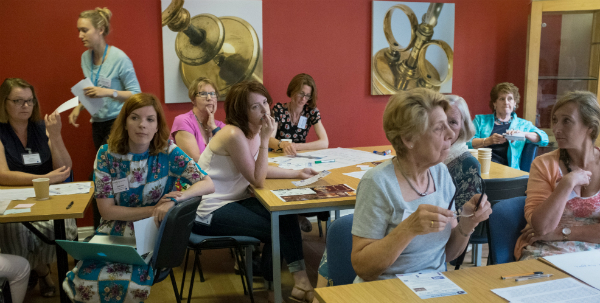Living with Dying: Past, Present and Future

Leeds Bereavement Forum Annual Conference 2017
In June the project supported and participated in a fantastic event organised by Leeds Bereavement Forum, which brought together academic and artistic projects with health practitioners to develop some really interesting and productive conversations about death and dying. The key question of the day was whether talking about death in the past might help people discuss their own bereavement in the present. Our project was there along with four others:
- We first heard from Katherine Baxter and Gabrielle Hamilton about the Dying Matters exhibition at Leeds City Museum - ends on 30 July and is brilliant so do go and see it! - which aimed to stimulate conversations around death, dying and loss. One of the ways in which they did this was to ask questions through the exhibition rather than providing a narrative for visitors to follow.
- Later Karina Croucher and colleagues from the University of Bradford spoke about their fascinating Continuing Bonds project. They are currently running workshops for healthcare professionals, using archaeology to inform contemporary palliative care and to challenge modern attitudes towards death and dying.
- Michelle Winslow from the University of Sheffield discussed her ongoing Oral History in Palliative Care project based at the Northern General Hospital, Sheffield. This is a really important project that records life history interviews with patients which are then passed onto the family and (with permission) deposited in the University of Sheffield archive for use by researchers.
- And Ellie Harrison, the artist behind the wonderful Grief Series displayed some of her work, and asked attendees to contribute to her collection of stories about where memories of the dead live.
In our workshop - run collaboratively between Laura King, Jessica Hammett, and Patrick Bourne from Abbey House Museum - we aimed to discuss the question 'What can objects tell us about death and dying?' Patrick began by showing some objects from the museum collections, but the ensuing conversation expanded to include not only objects, but also places, practices, sights and smells, and the difference between private and public grief.
Many of the workshop participants generously shared their thoughts and stories with us, and we had a really instructive conversation which touched on a number of issues that we had been thinking about:
- The first main one was the significance of personal practices vs wider cultural trends. There are certain routines which we follow, objects we save or places we visit because they are common practice within our culture or community. But often when a loved one dies there are more unusual objects or places which take on significance, sometimes quite unexpectedly. Is one more meaningful than the other? And do they have the same or different purposes?
- The problem of objects: Why do some feel more significant than others? What happens if they break? Do people worry about the responsibility of preserving objects? What if they stop being meaningful? Do you pass them down through the family as heirlooms, or does this risk making them a burden on later generations who don't really want them? Do objects ever regain significance for later generations?
- The difference between the feelings and practices around the death of loved ones and celebrity deaths and mass grief was another key theme. We might grieve when a celebrity who was important to us or who we respected dies, but it this the same kind of emotion that we feel when someone close to us dies? Why do we remember where we were when certain celebrities die, and why do we feel moved to participate in public events or ceremonies to mark these deaths?
- And we discussed some of the ways that dying, death and bereavement is dealt with within the different communities that our group members belonged to.
These are all really complicated and personal questions and, needless to say, no conclusions were reached at the conference! They are also all themes which we will continue to think about and which will inform our work – particularly the Remembrance exhibition at Abbey House Museum.
If you would like to participate in this conversation please leave a comment below.
You could also let us know what places, objects, practices and smells are significant to you.
Thank you to Lloyd Spencer for use of the above photograph.
